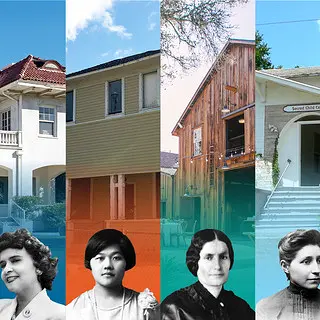
Meet the Women (and Places) Who Inspired Our Women’s History Campaign Design
Determination. Creativity. Courage. Resilience. These qualities are exemplified by the six women featured in our Where Women Made History campaign design: Marguerite Wildenhain, Della Williams, Sumi Harada, Encarnacion Vallejo Cooper, Dr. Susan La Flesche Picotte, and Leona Tate. And while their backgrounds cut across eras, professions, age, geography, religious beliefs, and race, they all exemplify how women are an essential part of our American history, and that every place has a woman’s story to tell.
Too often these stories are little-known, overlooked, or deliberately obscured. Get to know each of these dynamic women and the places where they made history.
Marguerite Wildenhain and Pond Farm
Trained as a ceramics artist in Germany and an apprentice at the Bauhaus for six years, Marguerite fled the Nazi régime eventually moving to California in 1940 to create Pond Farm, an arts environment and community in Guerneville. A skilled artist, inspirational mentor, and exacting teacher, she guided generations of ceramic artists from around the world by teaching that pottery was more than an art form or profession, but a way of life that promoted technical skills and a love of craft. Pond Farm is a new member of Historic Artists' Homes and Studios, a program of the National Trust.
Photos courtesy Stewards of the Coast and Redwoods.
Della Williams and the Wilfandel Club
Racial discrimination in Los Angeles prohibited people of color from utilizing public or private gathering places, but in 1947 Della Williams, with her friend Fannie Williams and a group of 50 friends, committed to changing this narrative by creating a clubhouse in the historic West Adam neighborhood for Black women across Los Angeles to join together in promotion of culture, civic betterment, and philanthropic endeavors. Today the Wilfandel Club continues this legacy of social, educational, and cultural activities as the oldest African American women’s club in LA.
Portrait courtesy the Williams Family Collection. Wilfandel Club by Joe Schmelzer.
Sumi Harada and the Harada House
With siblings Mine and Yoshizo, young Sumi Harada was at the center of a landmark 1918 court decision confirming the citizenship of the children of Japanese immigrants and establishing their right to own property in California. In spite of their US citizenship status, Sumi and the entire Harada family were forcibly removed on May 23, 1942, to government “relocation centers” where they were incarcerated during World War II. Sumi chose to return to the family home in Riverside after the war, opening it to displaced Japanese American families and providing a place for the victims of incarceration to rebuild their lives.
Photos courtesy Museum of Riverside staff.
Encarnacion Vallejo Cooper and the Cooper Molera Adobe
Encarnacion Vallejo Cooper represents the layered history of the families who built Monterey, from its early years as the capital of Mexico’s largest province through California’s statehood. But she also signifies the instrumental role that Mexican women played in property ownership and stewardship during this period. Raised in Monterey, she married sea captain and merchant John Bautista Rogers Cooper in 1827. He became a naturalized Mexican citizen, and together they settled in Monterey, helping to build the town into the economic, political, and social capital of Mexican Alta California. She raised their children in the Cooper Adobe while managing the family’s affairs during her husband’s long sea voyages, eventually becoming sole owner of the Cooper property in 1852. Thus began the chain of title through the women in the family—first to her eldest daughter, Anita Wohler Cooper, then to her granddaughter Frances Molera—that led to the Cooper Molera Adobe property becoming a National Trust Historic Site in 1968.
Portrait courtesy The Society of California Pioneers. Cooper Molera Adobe by Mike Steelman.
Dr. Susan La Flesche Picotte and the Susan La Flesche Picotte Memorial Hospital
In 1889, 24-year-old Susan La Flesche, a member of the Omaha Tribe, graduated as the valedictorian of her class from the Woman's Medical College of Pennsylvania, becoming the nation's first Native American doctor. For more than two decades "Dr. Susan" provided medical services to more than 1,000 patients across her 1,350-square-mile reservation, all while dreaming of building a modern hospital on her beloved homeland. That dream was realized in January 1913 with the Dr. Susan La Flesche Picotte Memorial Hospital, the first built on reservation land without using a single tax dollar. It provided vital medical services to the Omaha Nation and surrounding communities until 1964.
Portrait courtesy Drexel University College of Medicine. Susan La Flesche Picotte Memorial Hospital courtesy Wiki Commons.
Leona Tate and the McDonogh No. 19 Elementary School
On November 14, 1960, in New Orleans, 6-year-old Leona Tate became a pioneer of the American Civil Rights Movement when she, along with two other little girls, Gail Etienne and Tessie Prevost, were escorted by Federal Marshals through a crowd of shouting white protesters to attend McDonogh 19, becoming the first African Americans to attend formerly white-only schools in Louisiana. Today Ms. Tate continues her pursuit of equity and racial justice, purchasing the historic McDonogh No. 19 and transforming it into affordable housing for senior citizens and the TEP (Tate, Etienne, and Provost) Center for the history of New Orleans public school desegregation, civil rights, and restorative justice.
Photos courtesy Josh Hailey.
Donate Today to Help Save the Places Where Our History Happened.
Donate to the National Trust for Historic Preservation today and you'll help preserve places that tell our stories, reflect our culture, and shape our shared American experience.


.webp)
